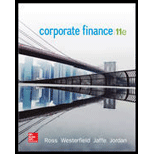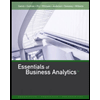
Case summary:
Person B has completed his graduation six years before, with an undergraduate degree in finance. His aim is to become an investment banker; however, he is satisfied with his present job. Person B was searching for the best college to do an MBA program, which he thinks would assist him in achieving his aim. He was looking for University W and College M. The details of Person B's current job and his course structure are provided.
Characters in the case:
- Person B
- University W
- College M
- Company DL
- College R
- College M
- School B
Adequate information:
- Person B is not allowed to work anywhere until the completion of the MBA program.
- The salaries are not paid for the internship course.
To calculate: The best option for Person B assumes that the increase in salary payment occurs at the end of every year.
Answer to Problem 3MC
Solution:
As the computed total value for each option is greater in the second option, the best option for Person B is to pursue an MBA at University W.
Explanation of Solution
Given information:
Person B currently works at a money management Company DL, whose salary is $65,000 for a year and is expected to rise to 3% in a year, until retirement. He is 28 years old and expects to be in employment for 40 more years. The average rate of tax payable by Person B is 26%.
College R at University W is one of the best programs for an MBA. It is a two-year full-time course. The fee is $70,000 annually and the cost of the book and other supplies is $3,000 for a year. After graduation, he will be employed for $110,000 with a bonus of $20,000. The salary will increase by 4% in a year and the rate of tax will rise by 31%.
School B at College M is less familiar than College R. It provides an accelerated program for one year with an annual fee of $85,000. The cost of books and other supplies for the program is expected to be $4,500. Person B would get an offer of $92,000 for a year after graduation, with a bonus of $18,000. The salary would rise to 3.5% for a year and the average rate of tax will be 29%.
Both the schools provide health insurance plans for the cost of $3,000 for a year, which must be paid at the beginning of the year. The board and room expenses will be $2,000 more for a year in both the schools. The rate of discount is 6.3%.
Note: Here, Person B has three choices; one is to remain in the same job, or to pursue an MBA at University W or at College M. As the board and room costs are not relevant, they will be the same even if Person B stays in his present job or attends the college. Compute the after-tax value under each choice.
If Person B chooses to remain at the present job, then his present after-tax value will be the following:
Formula to calculate after-tax value:
Compute the after-tax salary:
Hence, the after-tax value is $48,100.
Formula to calculate the
Note: g denotes the growing rate of annuity,
r denotes the rate of discount,
t denotes the number of years.
Compute the present value for a growing annuity:
Hence, the present value is $1,044,728.37.
If Person B chooses to pursue an MBA at University W, then his total value will be the following:
Formula to calculate the total direct costs:
Compute the total direct costs:
Hence, the total direct cost is $78,000.
Formula of present value of direct costs:
Compute the present value of direct costs:
Hence, the present value of the direct costs is $151,377.23.
Formula to calculate the present value of after-tax bonus:
Compute the present value of after-tax bonus:
Hence, the present value of the after-tax bonus of Person B is $12,212.72.
Formula to calculate the after-tax value:
Compute the after-tax value:
Hence, the after-tax value if Person B pursues MBA at University W is $75,900.
Note: As Person B’s salary will increase by 4% a year, compute the present value of after-tax of the increasing salary. Remember that Person B is expected to work for 38 more years.
Formula to calculate the present value for a growing annuity:
Note: g denotes the growing rate of annuity,
r denotes the rate of discount,
t denotes the number of years.
Compute the present value for a growing annuity:
Hence, the present value is $1,862,801.41.
As the initial payment of salary will be obtained three years from the present, discount the number of years to 2 to compute the present value.
Formula to calculate the present value for 2 years:
Compute the present value for 2 years:
Hence, the present value for 2 years is $1,648,542.05.
Formula to calculate the total value:
Compute the total value:
Hence, the total value, if Person B pursues an MBA in the University W is $1,509,377.54.
If Person B chooses to pursue an MBA at College M, then his total value will be the following:
Formula to calculate the total direct costs:
Compute the total direct costs:
Hence, the total direct costs are $94,500.
Note: This is also the present value costs, as they all are paid at present.
Formula to calculate the present value of the after-tax bonus:
Compute the present value of the after-tax bonus:
Hence, the present value of the after-tax bonus of Person B is $12,022.58.
Formula to calculate the after-tax value:
Compute the after-tax value:
Hence, the after-tax value if Person B pursues an MBA at the College M is $65,320.
Note: As Person B’s salary will increase at a rate of 3.5% in a year, compute the present value of after-tax of the increasing salary. Remember that Person B is expected to work for 39 more years.
Formula to calculate the present value for a growing annuity:
Note: g denotes the growing rate of annuity,
r denotes the rate of discount,
t denotes the number of years.
Compute the present value for a growing annuity:
Hence, the present value is $1,509,165.86.
As the initial payment of salary will be obtained two years from the present year, discount the number of years to 1 to compute the present value.
Formula to calculate the present value for 1 year:
Compute the present value for 1 year:
Hence, the present value for 1 year is $1,419,723.29.
Formula to calculate the total value:
Compute the total value:
Hence, the total value, if Person B pursues an MBA in College M is $1,337,245.87.
Want to see more full solutions like this?
Chapter 4 Solutions
Corporate Finance (The Mcgraw-hill/Irwin Series in Finance, Insurance, and Real Estate)
- In finance, we refer to the market where new securities are bought and sold for the first time? (a) Money market (b) Capital market (c) Primary market (d) Secondary marketarrow_forward1: ________ is shown on a multiple-step but not on a single-step income statement. A. Credited to Inventory B. A customer utilizes a prompt payment incentive. C. Debited to the Inventory account D. Gross profitarrow_forwardwhat is corporate finance? explain it.arrow_forward
- A lorenz curve graphs the _________________ received by everyone up to a certain quintile. A. Unequal distribution over time B. Normative shares of income C. Cumulative shares of income D. Total share of incomearrow_forwardNeedhdjxjx ususs shsharrow_forwardCalculate dividends for this question i need help.arrow_forward
- Please no spreadsheet workings.arrow_forwardQuestion 5 1 The common shares of Almond Beach Inc, have a beta of 0.75, offer a return of 9%, and have an historical standard deviation of return of 17%. Alternatively, the common shares of Palm Beach Inc. have a beta of 1.25, offer a return of 10%, and have an historical standard deviation of return of 13%. Both firms have a marginal tax rate of 37%. The risk-free rate of return is 3% and the expected rate of return on the market portfolio is 9½%%. 1. Which company would a well-diversified investor prefer to invest in? Explain why and show all calculations. 2. Which company Would an investor who can invest in the shares of only one firm prefer to invest in? Explain why. Use the following template to organize and present your results: Theoretical CAPM Actual offered Almond Beach Inc. Palm Beach Inc. prediction for expected return (%) return (%) Standard deviation of return (%) Beta Comments on the diversified investor's choice Comments on the individual investor's choicearrow_forwardsolve this question by using appropriate methodology and true answer.arrow_forward
 Essentials of Business Analytics (MindTap Course ...StatisticsISBN:9781305627734Author:Jeffrey D. Camm, James J. Cochran, Michael J. Fry, Jeffrey W. Ohlmann, David R. AndersonPublisher:Cengage Learning
Essentials of Business Analytics (MindTap Course ...StatisticsISBN:9781305627734Author:Jeffrey D. Camm, James J. Cochran, Michael J. Fry, Jeffrey W. Ohlmann, David R. AndersonPublisher:Cengage Learning Intermediate Financial Management (MindTap Course...FinanceISBN:9781337395083Author:Eugene F. Brigham, Phillip R. DavesPublisher:Cengage Learning
Intermediate Financial Management (MindTap Course...FinanceISBN:9781337395083Author:Eugene F. Brigham, Phillip R. DavesPublisher:Cengage Learning Cornerstones of Cost Management (Cornerstones Ser...AccountingISBN:9781305970663Author:Don R. Hansen, Maryanne M. MowenPublisher:Cengage Learning
Cornerstones of Cost Management (Cornerstones Ser...AccountingISBN:9781305970663Author:Don R. Hansen, Maryanne M. MowenPublisher:Cengage Learning Pfin (with Mindtap, 1 Term Printed Access Card) (...FinanceISBN:9780357033609Author:Randall Billingsley, Lawrence J. Gitman, Michael D. JoehnkPublisher:Cengage Learning
Pfin (with Mindtap, 1 Term Printed Access Card) (...FinanceISBN:9780357033609Author:Randall Billingsley, Lawrence J. Gitman, Michael D. JoehnkPublisher:Cengage Learning





